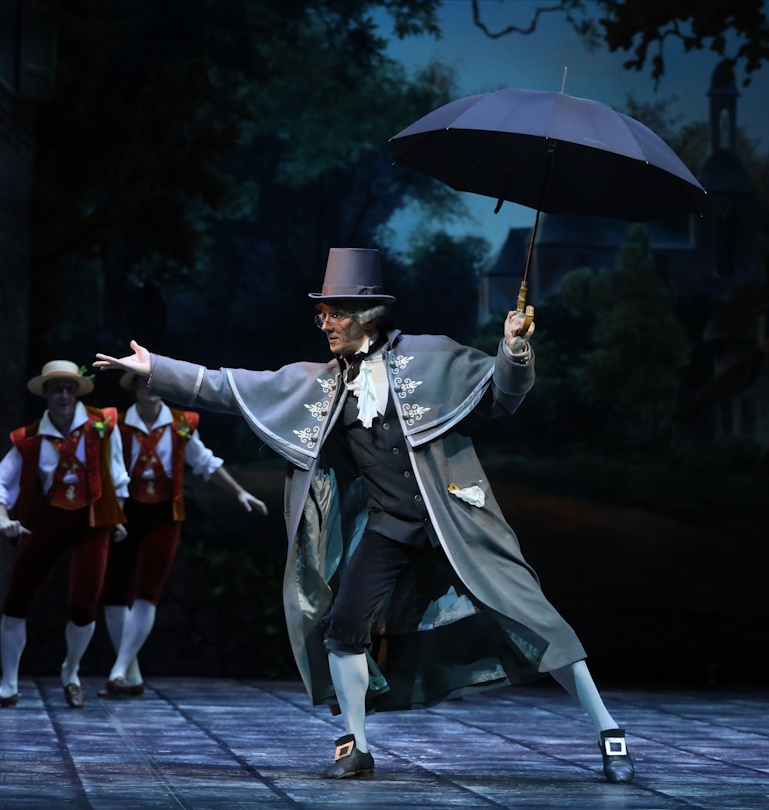Coppélia
ballet in three acts
music by Léo Delibes

Cast



At the heart of the plot of the Léo Delibes ballet Coppélia lies the story of a careless youth who nearly trades his lovely bride for a mechanical doll.
In the 150 years since its premiere, the show’s choreography has undergone numerous changes. In creating his version of Coppélia for the Mikhailovsky Theatre, Mikhail Messerer used elements of productions by his great predecessors in the world of classical ballet — Arthur Saint-Léon, Marius Petipa, and Alexander Gorsky, while his own sense of taste, imagination, and knowledge of tradition helped him create a show that functions as a cohesive whole.
This lively ballet, with elements of pantomime and colourful distinctive variations, but with strictly classical dancing at its core, makes for ideal family viewing.
Act one
A charming girl has taken up residence with the eccentric doctor Coppelius. The townspeople think she is his daughter and name her Coppelia. The young men try unsuccessfully to meet her. Franz is lucky: the beautiful girl blows him a kiss from the window, which causes him to quarrel with his fiancée Swanhilda.
Evening. Merry young people tease Coppelius. The master fends them off and leaves, losing his key in the commotion. Swanhilda and her friends find the key and decide to sneak into the house. Coppelius returns, finds the door open and quietly enters, intending to catch the uninvited guests. Franz decides to climb through the window into the mysterious stranger’s house, unaware that Swanhilda and the master are already inside.
Act two
Swanhilda and her friends explore a marvellous filled with dolls and discover that the mysterious stranger is also a doll. Overjoyed, the girls wind up all the toys and start dancing. Coppelius catches them, but everyone except Swanhilda manages to escape. At that moment, Franz appears at the window. Swanhilda complains to the good master about the young man’s treachery, and Coppelius suggests that she teach Franz a lesson.
After getting Franz drunk, Coppelius introduces him to a beautiful “stranger” in whose costume Swanhilda has disguised herself. He tells Franz that it is a doll and that it can be brought to life. Franz doesn’t believe him, but he is convinced when he hears the doll’s heartbeat. He asks Coppelius for the girl’s hand in marriage. Swanhilda tears off her wig and makes Franz repent for his behaviour. The young man begs for her forgiveness. Franz’s repentance is so sincere, and their mutual love so obvious, that Coppelius decides to reconcile the lovers.
Act three
A celebration in the square. Coppelius presents the townspeople with a new clock for the town hall. Traditionally, weddings are also celebrated on this day. Several young couples are getting married, including Swanhilda and Franz. Coppelius gives the newlyweds a small doll as a token of their faithful love.
Premiere of the production: 2 October 2020
Original libretto by Charles Nuitter and Arthur Saint-Léon based on The Sandman by E. T. A. Hoffmann
The production includes choreographic motifs and elements from versions by Arthur Saint-Léon, Marius Petipa, Enrico Cecchetti, and Alexander Gorsky
- StagingMikhail Messerer
- Stage Design and CostumesVyacheslav Okunev
- Lighting DesignerAlexander Kibitkin
- Musical DirectorPavel Sorokin
- Ballet Master’s AssistantsAnna Razenko, Evgeny Popov
- Stage Designer’s AssistantsSergey Novikov, Larisa Ivushkina
- Musical Director’s AssistantAlexey Repnikov
- Principal PianistsNatalia Spichka, Elena Panova




















